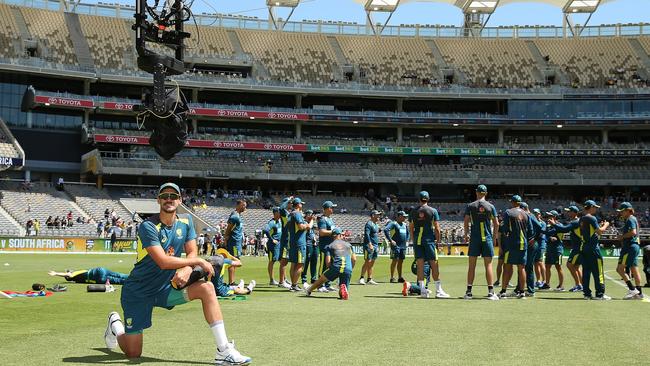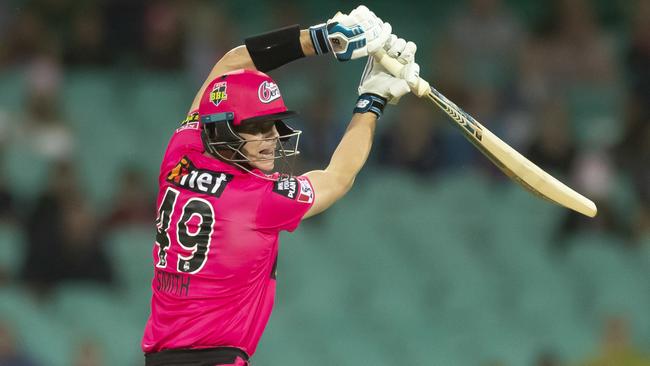Potential rights bidders dissatisfied with BBL’s star power
Cricket Australia’s refusal to offer Steve Smith a BBL deal encapsulates broadcasters frustrations, writes Ben Horne.

Cricket
Don't miss out on the headlines from Cricket. Followed categories will be added to My News.
Cricket Australia’s ongoing refusal to make Steve Smith a Big Bash offer has encapsulated the bigger picture standoff brewing over TV rights.
With negotiations well underway, Cricket Australia has so far invited prospective broadcasters to bid on the four separate packages of Test cricket, white ball internationals, BBL and WBBL.
The exercise increases Cricket Australia’s flexibility to strike the best deal possible in a complicated market, but it has also highlighted the massive discrepancy that exists between peaking interest in international cricket and the prevailing dissatisfaction over the men’s BBL.
Current broadcasters Channel 7 and Fox Sports are both reportedly unhappy with the Big Bash, Channel 9 are virtually a non-player because they show the Australian Open Tennis in January, while sources say even Channel 10 have concerns over the current shape of the competition it once owned and loved.
Despite talk of the Australian men’s team being on the nose and one-day cricket being in crisis, broadcast interest in Tests and white ball internationals has never been higher and CA will have no trouble selling these packages.
The WBBL is also impressing after outrating men’s A-League, AFLW and the men’s NBL in the packed month of October dominated by the men’s T20 World Cup.
However, there is deep frustration from broadcasters about Cricket Australia’s continued denial that the men’s Big Bash is a distressed asset in need of major changes.

With two summers to run on the current rights deal with Seven and Fox, and hope that this coming season could be the best for years, CA is sticking to its guns that the BBL is still Australia’s best pound for pound sporting league.
Despite the feedback of broadcasters that the competition is too long, CA will still not cave in on its position that 61 games is sustainable.
David Warner’s signing for the next two BBL seasons is a massive boon, but the overall riddle of how to insist Australian stars play the Big Bash remains largely unsolved, albeit a new collective bargaining agreement is due next year.
The Australian Test team may now head into camp for the Indian Test tour in late January, potentially cutting into the number of matches Warner and stars like Marnus Labuschagne, Usman Khawaja, Cameron Green, Travis Head, Nathan Lyon and Alex Carey can play, on top of the fact fast bowlers Pat Cummins, Mitchell Starc and Josh Hazlewood won’t play due to workloads.
Standing out on stalks for many is the mysterious question ... why won’t Cricket Australia just show Steve Smith the money and seize an opportunity to boost the BBL’s star power?
In the past week or so, Glenn Maxwell – the greatest player in Big Bash history – has broken his leg and could miss the entire tournament in a monumental blow that cannot be underplayed. The Sydney Thunder had David Willey (the only platinum overseas star in the draft) pull out of his contract, and the Melbourne Renegades have had the BBL’s overall No.1 pick Liam Livingstone also withdraw.
Balancing out the bad news is the fact Perth Scorchers appear poised to sign Faf du Plessis for the first half of the season which is a great signing, while the Renegades have snared kiwi gun Martin Guptill.
But the fact Cricket Australia is still refusing out of principle to provide a financial incentive for home grown superstar Smith to play a few games is still leaving many scratching their heads.

CA has drawn a line that the marketing contract handed to Warner was a one-off exception, and does not want to set a precedent where it is continually forced to prop up the salaries of international stars.
However, in a summer where the Big Bash is literally on trial, as Channel 7 takes the extraordinary measure of suing CA in the Federal Court for breach of contract, there would appear a strong argument for Cricket Australia to perhaps make an exception like hunting Smith … when something as crucial as lifting the value of the BBL for the next TV rights deal is at stake.
Big Bash insiders might point to Smith’s falling star as a T20 cricketer as a reason against boosting him up to a Warner-style $350,000 deal. But it is missing the point.
T20 prowess is not necessarily the definition of star power in the Big Bash, and Smith remains a massive drawcard in Australian cricket, particularly for Sydney audiences.
Perhaps even more so after his T20 snub proved the biggest talking point of Australia’s failed T20 World Cup campaign.
Smith might not be the TV rights silver bullet, but his sidelining has only reinforced the frustration of broadcasters that Cricket Australia aren’t listening to them when they warn the Big Bash is the game’s biggest problem.
CA’S BIGGEST PAYOUT MAY BE WORST BROADCAST BET
Channel 10 has offered top dollar for cricket’s TV rights, but at the same time its ratings are bottoming out to a level that will have Cricket Australia bosses acutely concerned.
Industry statistics say Ten is headed down a slippery slope to becoming the first free-to-air network in Australia to ever drop below a 20 per cent audience share, after falling behind the ABC this year.
Ten have never been further behind rivals Nine and Seven in the ratings three-horse race, losing audience share year on year at the same time Nine and Seven are growing their numbers.
At a metro level, Ten fell -0.3 points behind the ABC this year to now rank as Australia’s fourth network when all are included, and should the trends continue, a previously inconceivable low point could occur in 2023 where Ten will fall below a 20 per cent share.
The startling numbers paint an intriguing picture as Cricket Australia’s TV rights negotiations begin to heat up.

News Corp has been told that cashed-up Ten and Paramount is the early leading bidder in the CA negotiations, with the process now up to second round bids.
But Ten’s bumper offer only adds another layer to the reality that CA’s search for a free-to-air partner is highly complex.
Complications and compromises exist with every option.
Channel 7 is trying to terminate its current deal with Cricket Australia in the Federal Court and it would be a stunning turn of events for CA to choose to partner with the network again.
Channel 9 meanwhile, has already extended and upgraded its Australian Open Tennis rights, putting a strict limit on how much cricket it could actually broadcast, not to mention how much money they’d have left over to spend.
If CA went with Nine for Test cricket it could also create a situation where tennis is being promoted during the coverage – the Australian Open being the direct rival of the Big Bash League.
In Channel 10, the money is there, but the risk is partnering with a network with a reputation for being the place where sports fade away.
Cricket Australia may take confidence from the success the Big Bash enjoyed on Ten and back the quality of Test cricket in particular to rise above the tide.
But the declining year on year ratings of the Melbourne Cup on Ten as well as its overall metro and national share dropping to 22.1 per cent this year are alarm bells not easy to cast aside.
More Coverage
Originally published as Potential rights bidders dissatisfied with BBL’s star power





